Research News
-
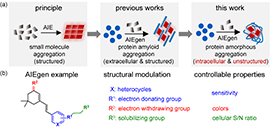 06 08, 2021Researchers Design Sensors to Detect Amorphous Protein AggregationResearchers from DICP rationally designed amorphous protein aggregation sensors from aggregation induced emission probes (AIEgens).
06 08, 2021Researchers Design Sensors to Detect Amorphous Protein AggregationResearchers from DICP rationally designed amorphous protein aggregation sensors from aggregation induced emission probes (AIEgens).
Most current protein aggregation sensors focus on amyloid proteins for their well-defined β-sheet stacked structure. Intracellular amorphous protein aggregation with random and indefinite structure is usually envisioned to be untargetable or undruggable by small molecule probes.
Recently, Prof. LIU Yu's group and Prof. PIAO Hailong's group from the Dalian Institute of Chemical Physics (DICP) of the Chinese Academy of Sciences (CAS), in collaboration with Prof. LIU Xiaojing from Shandong University, designed amorphous protein aggregation sensors from aggregation induced emission probes (AIEgens), and systematically investigated the structure-fluorescence relationship to dissect structural moieties.
This study was published in Angewandte Chemie International Edition on May 14.
Rational design of crystallization induced emission probes to detect amorphous protein aggregation in live cells (Image by SHEN Di)
This sensor achieved the selective detection via its inherent binding affinity towards amorphous aggregated proteins. Due to the low-polarity and high-viscosity microenvironment inside aggregated proteins, the environment-sensitive sensor turned on its fluorescence upon binding these aggregated proteins.
"This work may provide a new strategy for further design of imaging sensors, proteomics probes, and therapeutic reagents for amorphous aggregated protein," said Prof. LIU.
This work was supported by the National Natural Science Foundation of China, Liaoning Revitalization Talents Program, China Postdoctoral Science Foundation Grant, and Dalian Innovation Fund. (Text by SHEN Di) -
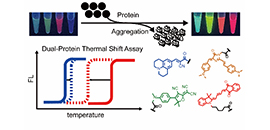 06 07, 2021Researchers Quantify Thermodynamic Interplay during Protein Co-aggregationScientists developed a dual-color fluorogenic thermal shift assay to simultaneously report on the aggregation of two different proteins and quantitatively study their thermodynamic stability during co-aggregation.
06 07, 2021Researchers Quantify Thermodynamic Interplay during Protein Co-aggregationScientists developed a dual-color fluorogenic thermal shift assay to simultaneously report on the aggregation of two different proteins and quantitatively study their thermodynamic stability during co-aggregation.
Co-aggregation of multiple pathogenic proteins is common in neurodegenerative diseases. However, the deconvolution of such biochemical process is still challenging.
Recently, a research group led by Professor LIU Yu from the Dalian Institute of Chemical Physics (DICP) of the Chinese Academy of Sciences developed a dual-color fluorogenic thermal shift assay to simultaneously demonstrate the aggregation of two different proteins and quantitatively study their thermodynamic stability during co-aggregation.
This study was published in Chemical Science on May 20.
A series of multi-color protein aggregation sensors and a dual-color thermal shift assay to report on protein co-aggregation of two different proteins simultaneously and quantitatively (Image by BAI Yulong)
The researchers developed multi-color fluorogenic protein aggregation sensors to expand spectral coverage. Then they quantified shifts in melting temperatures in a heterozygous model protein system, which revealed that the thermodynamic stability of wild-type proteins was significantly compromised by the mutant ones but not vice versa.
They also examined how small molecule ligands selectively and differentially interfered with such interplay.
"These sensors are suited to visualize how different proteins exert influence on each other upon their co-aggregation in live cells," said Prof. LIU.
In particular, they investigated how amyloidogenic transthyretin proteins interact with apolipoprotein IV proteins during their co-aggregation process, which indicated the apolipoprotein IV was a pharmacological chaperone.
This work was support by National Natural Science Foundation of China, the Liaoning Revitalization Talents Program, China Postdoctoral Science Foundation Grant, and Pfizer ASPIRE award for transthyretin amyloidosis basic research. (Text by BAI Yulong) -
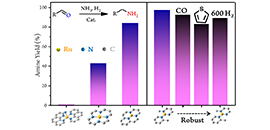 06 07, 2021New Single-atom Catalysis Boots Reductive Amination ReactionScientists fabricated a Ru1/NC SAC with good catalytic activity, selectivity and stability in reductive amination of biomass derived aldehydes/ketones to produce primary amines, and elucidated the structure-performance relationships from the atomic/molecular level.
06 07, 2021New Single-atom Catalysis Boots Reductive Amination ReactionScientists fabricated a Ru1/NC SAC with good catalytic activity, selectivity and stability in reductive amination of biomass derived aldehydes/ketones to produce primary amines, and elucidated the structure-performance relationships from the atomic/molecular level.
The geometric isolation of metal species in single-atom catalysis (SACs) not only maximizes the atomic utilization efficiency, but also endows SACs with unique selectivity in various transformations.
The coordination environment of isolated metal atoms in SACs determines the catalytic performance. However, it remains challenging to modulate the coordinative structure while still maintain the single-atom dispersion.
Recently, a research group led by Prof. ZHANG Tao and Prof. WANG Aiqin from the Dalian Institute of Chemical Physics of the Chinese Academy of Sciences fabricated Ru1/NC SAC with good catalytic activity, selectivity and stability in reductive amination of biomass derived aldehydes/ketones to produce primary amines, and elucidated the structure-performance relationships from the atomic/molecular level.
This study was published in Nature Communications on June 2.
Highly selective and robust single-atom catalyst R1/NC for reductive amination of aldehydes/ketones (Image by QI Haifeng)
The researchers prepared Ru1/NC SAC towards the target reaction, and discovered both catalytic activity and selectivity increased with the decrease of Ru-N coordination numbers.
Particularly, Ru1/NC SAC with Ru1-N3 moiety offered the best catalytic performances, which was much superior to the ever reported nanoparticulate and homogeneous Ru catalysts.
Moreover, Ru1/NC presented excellent durability against poisoning by CO or sulfur-containing compounds, and the single-atom dispersion was well maintained even after reduction under extreme conditions.
This work was supported by the National Key Projects for Fundamental Research and Development of China, the National Natural Science Foundation of China, and the Strategic Priority Research Program of the CAS. (Text by QI Haifeng) -
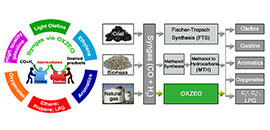 06 04, 2021Oxide-zeolite-based Composite Catalyst Concept Enables Syngas Chemistry beyond Fischer-Tropsch SynthesisResearchers summarized the state of the art, opportunities and challenges of the OXZEO catalysis concept in the field of C1 chemistry.Fischer-Tropsch synthesis (FTS) has been applied as the core technology of coal-to-liquid and gas-to-liquid processes in industry. However, the product selectivity control of syngas conversion still remains challenging.A group led by Prof. PAN Xiulian and Prof. BAO Xinhe from the Dalian Institute of Chemical Physics of the Chinese Academy of Sciences (CAS) proposed the oxide-zeolite-based composite (OXZEO) catalysis concept, which can separate activation of reactants CO and H2, and C-C coupling onto two different types of active sites.Recently, the researchers summarized the state-of-the-art, opportunities and challenges of the OXZEO catalysis concept in the field of C1 chemistry. The study was published in Chemical Reviews on May 25.Oxide–zeolite-based composite catalyst concept that enables syngas chemistry beyond Fischer–Tropsch synthesis (Image by JIAO Feng and MIAO Dengyun)The concept turned syngas conversion into a tandem reaction and allowed the product selectivity to be manipulated by shape-selective zeolites. It enabled direct conversion of syngas to a variety of chemicals and fuels with their selectivity surpassing the limit predicted by Anderson-Schultz-Flory model via the conventional FTS route.A rapidly increasing number of studies showed that OXZEO formed a new technology platform for efficient utilization of carbon resources such as coal, natural gas and biomass via syngas in addition to FTS and methanol technologies, as well as utilization of CO2 as a carbon resource via hydrogenation to a variety of chemicalsHowever, the selectivity control mechanism is far from being understood. Therefore, further studies should focus on the selectivity control mechanism of the OXZEO concept in order to understand the challenges and prospects for future development of much more active and more selective catalysts.This work was supported by CAS, the Ministry of Science and Technology of China, and National Natural Science Foundation of China. (Text by JIAO Feng and MIAO Dengyun)
06 04, 2021Oxide-zeolite-based Composite Catalyst Concept Enables Syngas Chemistry beyond Fischer-Tropsch SynthesisResearchers summarized the state of the art, opportunities and challenges of the OXZEO catalysis concept in the field of C1 chemistry.Fischer-Tropsch synthesis (FTS) has been applied as the core technology of coal-to-liquid and gas-to-liquid processes in industry. However, the product selectivity control of syngas conversion still remains challenging.A group led by Prof. PAN Xiulian and Prof. BAO Xinhe from the Dalian Institute of Chemical Physics of the Chinese Academy of Sciences (CAS) proposed the oxide-zeolite-based composite (OXZEO) catalysis concept, which can separate activation of reactants CO and H2, and C-C coupling onto two different types of active sites.Recently, the researchers summarized the state-of-the-art, opportunities and challenges of the OXZEO catalysis concept in the field of C1 chemistry. The study was published in Chemical Reviews on May 25.Oxide–zeolite-based composite catalyst concept that enables syngas chemistry beyond Fischer–Tropsch synthesis (Image by JIAO Feng and MIAO Dengyun)The concept turned syngas conversion into a tandem reaction and allowed the product selectivity to be manipulated by shape-selective zeolites. It enabled direct conversion of syngas to a variety of chemicals and fuels with their selectivity surpassing the limit predicted by Anderson-Schultz-Flory model via the conventional FTS route.A rapidly increasing number of studies showed that OXZEO formed a new technology platform for efficient utilization of carbon resources such as coal, natural gas and biomass via syngas in addition to FTS and methanol technologies, as well as utilization of CO2 as a carbon resource via hydrogenation to a variety of chemicalsHowever, the selectivity control mechanism is far from being understood. Therefore, further studies should focus on the selectivity control mechanism of the OXZEO concept in order to understand the challenges and prospects for future development of much more active and more selective catalysts.This work was supported by CAS, the Ministry of Science and Technology of China, and National Natural Science Foundation of China. (Text by JIAO Feng and MIAO Dengyun) -
 06 04, 2021Controlling Film Formation to Improve Performance of Dion-Jacobson 2D Perovskite Solar CellsResearchers achieved high performance DJ 2D perovskite solar cells by controlling the film formation.
06 04, 2021Controlling Film Formation to Improve Performance of Dion-Jacobson 2D Perovskite Solar CellsResearchers achieved high performance DJ 2D perovskite solar cells by controlling the film formation.
The Dion-Jacobson (DJ) two-dimensional (2D) hybrid perovskite semiconductor is promising due to its outstanding stability and excellent optoelectronic properties.
Recently, a group led by Prof. LIU Shengzhong (Frank) from the Dalian Institute of Chemical Physics (DICP) of the Chinese Academy of Sciences (CAS), in collaboration with Prof. ZHAO Kui from Shaanxi Normal University, achieved high performance DJ 2D perovskite solar cells by controlling the film formation.
This study was published in Advanced Energy Materials on March 31.
Through in situ analysis of film formation, the researchers investigated the crystallization mechanism from liquid precursors to the solid film, as well as how it would influence multiple quantum well (QW) growth, charge transport, and solar cell performance.
They found that faster taking of solvent during spinning process enabled faster nucleation and growth during spinning, which avoided indirect transformation from intermediate phases to perovskites. Therefore, better film quality and more uniform thickness distribution of QWs could be achieved.
The improved optoelectronic properties including higher efficient charge transport, higher carrier lifetime, and mobility finally translated to the improvements of short circuit current density and open circuit voltage. This led to a power conversion efficiency (PCE) as high as 15.81%, the higher for aromatic spacer-based DJ perovskite solar cells.
This work was supported by the National Key Research and Development Program of China, National Natural Science Foundation of China, National University Research Fund, and the 111 Project. (Text by ZHANG Xu) -
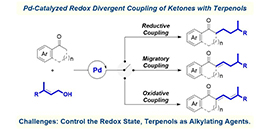 06 03, 2021New Strategy Developed for Redox Divergent Coupling of Ketones with TerpenesResearchers developed a Pd-catalyzed redox divergent coupling of ketones with terpenols to access α-substituted ketones with varying degrees of unsaturation.
06 03, 2021New Strategy Developed for Redox Divergent Coupling of Ketones with TerpenesResearchers developed a Pd-catalyzed redox divergent coupling of ketones with terpenols to access α-substituted ketones with varying degrees of unsaturation.
Hydrogenation and dehydrogenation are two important artificial methods to change the redox state of compounds. However, most of the current research focuses on mono redox transformation, and the corresponding regulation of redox divergent couplings with artificial catalysts still remain challenging.
Recently, a team led by Prof. CHEN Qing'an from the Dalian Institute of Chemical Physics (DICP) of the Chinese Academy of Sciences (CAS) developed a strategy to realize Pd-catalyzed redox divergent coupling of ketones with terpenols to access α-substituted ketones with varying degrees of unsaturation.
Their study was published in ACS Catalysis on May 27.
Pd-Catalyzed Redox Divergent Coupling of Ketones with Terpenols (Image by ZHAO Chaoyang)
The researchers employed different additives to facilitate the control of oxidation states of the product, and found that reductive coupling pathway was thermodynamically favored with the aid of BnOH as an external hydrogen source.
They used LiBr as the additive to reduce the reactivity of Pd-H, in order to divert the selectivity toward α, β-unsatuated ketones. By switching the solvent from toluene to chlorobenzene, the active species Pd-H would be fully quenched to enable oxidative coupling.
"This redox divergent coupling protocol provides an important complement for known precedents on Tsuji-Trost allylation of ketones" said Prof. CHEN.
The research was supported by DICP, Dalian Outstanding Young Scientific Talent, and the National Natural Science Foundation of China. (Text by ZHAO Chaoyang)